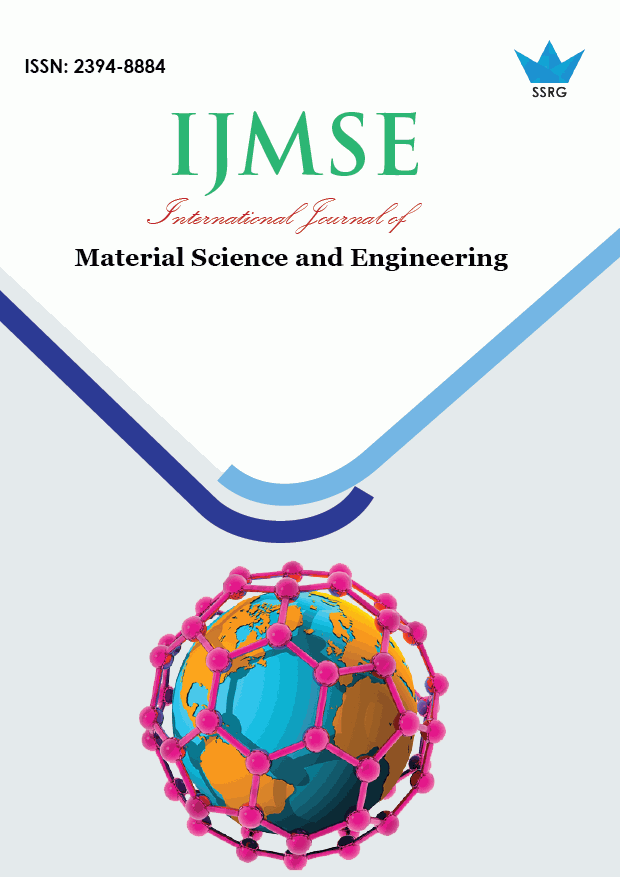Analyzing The Effect of Machining Parameters For Titanium (Grade 5) Alloy

| International Journal of Material Science and Engineering |
| © 2020 by SSRG - IJMSE Journal |
| Volume 6 Issue 2 |
| Year of Publication : 2020 |
| Authors : G.T.Suriyaprabakaran, M.Kavin, R.Govindaraj |
How to Cite?
G.T.Suriyaprabakaran, M.Kavin, R.Govindaraj, "Analyzing The Effect of Machining Parameters For Titanium (Grade 5) Alloy," SSRG International Journal of Material Science and Engineering, vol. 6, no. 2, pp. 9-22, 2020. Crossref, https://doi.org/10.14445/23948884/IJMSE-V6I2P102
Abstract:
Titanium alloys are commonly used in industry, automotive, medical and all manufacturing applications.Unconventional machining process which offers lesser micro structural changes and less internal stresses produced during machining compare to traditional machining process. In this project Titanium Grade 5 alloy is machined by using WEDM process with different feed rates and the mechanical property changes are to be investigated. WEDM has since the process' launch emerged as the best option to manufacture micro parts with the highest degree of dimensional precision and surface finish consistency from a simple way to manufacture instruments and die. The machining parameters like kerfs width, material removal rate, feed rate, wire speed, wire tension and voltage are the factors influencing the mechanical properties and micro structure changes. Out of these parameters, the feed rate is varied and the properties like hardness, surface finish and micro structure changes are to be investigated and the best suitable feed rate for machining the titanium grade 5 alloy is to be identified.
Keywords:
Titanium alloy, WEDM, Material removal rate, SEM analysis, Hardness.
References:
[1] Y.S. Liao, J.T. Huang, Y.H. Chen (2004) “A study to achieve a fine surface finish in Wire EDM”, Journal of Materials Processing Technology, Vol.149, pp. 165–171
[2] ShajanKuriakose, M.S. Shunmugam (2004) “Characteristics of wire electro discharge machined Ti6Al4V surface” Materials Letters, Vol.58, pp. 2231-2237.
[3] Vamsi Krishna Pasam, SurendraBabuBattula, MadarValli P, Swapna(2004) “Optimizing surface finish in WIER -EDM using the Taguchi parameter design method” GITAM University.
[4] K.H. Ho, S.T. Newman, S. Rahimifard, R.D. Allen (2004) “State of the art in wire electrical discharge machining (WEDM) ”, International Journal of Machine Tools & Manufacture, Vol.44, pp. 1247–1259.
[5] Scott F. Millera, Chen-C. Kaoa, Albert J. Shiha, Jun Qub (2005) “Investigation of wire electrical discharge machining of thin cross sections and compliant mechanisms” , International Journal of Machine Tools & Manufacture, Vol.45, pp. 1717–1725.
[6] S. Sarkar, S. Mitra, B. Bhattacharyya (2005) “Parametric analysis and optimization of wire electrical discharge machining of titanium aluminidealloy”, Journal of Materials Processing Technology, Vol.159, pp.286–294.
[7] Neeraj Sharma, Rajesh khanna(2010) “Optimization of process parameters of cryogenic treated D-3 in WEDM by Taguchi Approach”, International Journal of Engineering Research and Applications (IJERA)Vol. 1, pp.546-553.
[8] Okada, Y. Uno, M. Nakazawa, T. Yamauchi (2010) “Evaluations of spark distribution and wire vibration in wire EDM by high-speed observation”, Department of Manufacturing Technology, CIRP Annals - Manufacturing Technology, Vol.59, pp. 231–234
[9] AnizaAliasa, BulanAbdullaha, NorlianaMohdAbbasa (2012) “Influence of machine feed rate in WEDM of titanium TI-6AL-4V with constant current (6A) using brass wire”,International Symposium on Robotics and Intelligent Sensors, Procedia Engineering, Vol.41 pp. 1806 – 1811.
[10] PragyaShandilya, P.K.Jain, N.K. Jain (2012) “Parametric optimization during wire electrical discharge machining using response surface methodology”, Procedia Engineering Vol.38, pp.2371 – 2377.
[11] Kali Dass, S. R. Chauhan (2011) “Machinability Study of Titanium (Grade-5) Alloy Using Design of Experiment Technique”, Research gate, Page no: 609-621.
[12] G. Dongre, J. Shaikh (2017) “Analysis for Machining of Ti6Al4V Alloy Using Coated and Non-Coated carbide tools, Advances in Intelligent Systems Research, Page no: 134-141.
[13] BogdanSłodki, WojciechZebala (2019) “Turning Titanium Alloy, Grade 5 ELI, With the Implementation of High Pressure Coolant”, Production Engineering Institute of the Mechanical Faculty, Cracow University of Technology, Page no: 2-14.
[14] Mohammed Nouari and Hamid Makich (2014) “On the Physics of Machining Titanium Alloys: Interactions between Cutting Parameters, Microstructure and Tool Wear”, University of Lorraine, Page no: 338-358.
[15] PatilAmit S et al., (2015) “Machining Challenges in Ti-6Al-4V.-A Review”, International Journal of Innovations in Engineering and Technology, Page no: 6-23.

 10.14445/23948884/IJMSE-V6I2P102
10.14445/23948884/IJMSE-V6I2P102